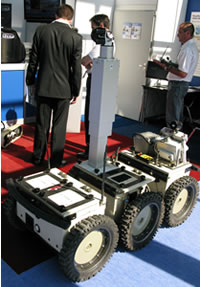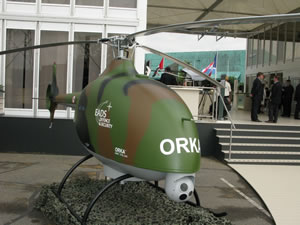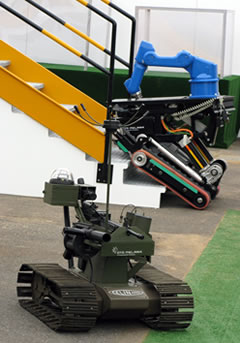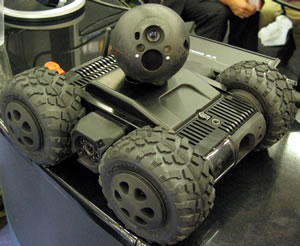A wide range of Unmanned Ground Vehicles (UGVs) displayed at Eurosatory 2008 indicated how advanced these systems became and how popular they become withdefense forces. However, despite the considerable advances, most systems on display were still experimental, with only a few such as EOD/IED robots such as the iRobot PacBot, and the Talon from QinetiQ, and the Israeli Guardium autonomous patrol vehicle from G-Nius, considered mature for operational use.
 Some of the French and Italian UGV R&D programs were on display at Eurosatory 2008, among them the Miniroc program evaluating the combined use of robotic, unmanned systems in a variety of stand-alone and integrated tasks.
Some of the French and Italian UGV R&D programs were on display at Eurosatory 2008, among them the Miniroc program evaluating the combined use of robotic, unmanned systems in a variety of stand-alone and integrated tasks.
The MiniRoc concept relies on the combination of several modular ‘plug and play’ payloads, each dedicated to a particular function. Most of these modules are compatible with two complementary platforms differing in terms of weight, volume, speed and energy. Among the payloads currently evaluated are surveillance systems (target detection, tracking, acoustic inspection etc.), Reconnaissance (visual inspection, mapping and localization) and support (load carrying mule, objects manipulator, communications relay, fire support etc.) The MiniRoc family includes a 6×6 heavy support robot, weighing 60 kg it is capable of carrying a 100 kg payload at a speed of 15 km/h and operate for 4-8 hours. A smaller scout robot is capable of indoor and outdoor operations, including stairs climbing. It weighs about 26 kg and can travel at a speed of 7.5 km/h for 2.5 hours. The smallest robot of the family is the Mini-Robot, designed for indoor applications, such as in-building reconnaissance, underground inspection of subterranean spaces, under vehicle inspection etc. Mini Robot weighs 2.1 kg, travels at a speed of 2 km/h for one hour.
Thales is also working on a similar program with its Robotic-Trooper (R-Trooper) program. This experimental 6×6 robotic platform is being tested demonstrating various levels of autonomous behavior, from basic tele-operation to fully autonomous mission execution. The system incorporates various levels of propulsion extending operating range, mission endurance, and employment of marsupial capabilities, to deploy smaller robots for reconnaissance, network establishment and surveillance.
The Italian company OtoMelara introduced at Eurosatory 2008 a line of new robotic platforms developed by the newly acquired Celin Avio division. One of the smallest and most innovative systems is the Oto-Horus, a 120mm diameter, 1.3 kg gross T/O weight tube-launched mini-UAV designed for launching from 120mm tank guns. Horus is built from composite materials, and uses foldable canard and forward-swept main wings, optimizing stability, maneuverability and platform dimension. Horus is fitted with an electro-optical payload and can fly a mission for 30 minutes at maximum speed of about 100 km/h.
 A heavier platform is the Oto Praetor, six-wheeled platform designed for reconnaissance and counter IED missions. In addition to operating autonomously, Oto-Praetor can be used as a launch pad or ‘mothership’ for smaller robots, employing ‘dog and flea’ operating concept (elsewhere referred to as ‘marsupial’ design). Either miniature wheeled bots, or miniature helicopters, are used to explore and monitor hard-to-reach locations. Praetor weighs about 240 kg of which 60 kg are payload weight. It will be powered by six electrical motors accelerating the robot to a top speed of 50 km/h. At Eurosatory Oto-Melara demonstrated the Praetor with two types of ‘fleas’ – the miniature helicopter platform designated TRPP-5 IBIS, a 10kg gross take-off weight autonomous helicopter carrying a 3 kg payload and the miniature four wheeled TRP-3 mini-UGV weighing 5.5 kg, carrying a payload of 1 kg.
A heavier platform is the Oto Praetor, six-wheeled platform designed for reconnaissance and counter IED missions. In addition to operating autonomously, Oto-Praetor can be used as a launch pad or ‘mothership’ for smaller robots, employing ‘dog and flea’ operating concept (elsewhere referred to as ‘marsupial’ design). Either miniature wheeled bots, or miniature helicopters, are used to explore and monitor hard-to-reach locations. Praetor weighs about 240 kg of which 60 kg are payload weight. It will be powered by six electrical motors accelerating the robot to a top speed of 50 km/h. At Eurosatory Oto-Melara demonstrated the Praetor with two types of ‘fleas’ – the miniature helicopter platform designated TRPP-5 IBIS, a 10kg gross take-off weight autonomous helicopter carrying a 3 kg payload and the miniature four wheeled TRP-3 mini-UGV weighing 5.5 kg, carrying a payload of 1 kg.
Another platform designated OTO TRP2 is designed specifically for armed applications. This tele-operated robotic system is currently used by the company for technical evaluation of potential missions and uses. The OTO has a maximum weight of 110 kg, of which up to 80 kg are payload comprising of a light machinegun (Minimi 5.56mm), grenade launcher/revolver with six shots, two smoke grenades and electro-optical aiming sight. The payload also includes electrical batteries, supporting four hours of continued operation, at a top speed of 35 kph. Oto-Melara also unveiled a stairs climbing robot, designed for urban operations and assistance to firefighters.
A small robot called EyeDrive on display at the Israeli ODF Optronics stand has an omni-panoramic vision (360 degrees) and an innovative “point ‘n go” autonomous control enabling effective movement in restricted space. Two EyeDrive robots can operate simultaneously on every mission toward optimal performance. The robot is launched on a mission, hand-thrown over a wall, through a window or into a tunnel. Before trown onto its mission the robot is placed in its protective case, which also absorbs some of the impact and can act as a communications node, improving radio link in confined spaces such as underground complexes, indoor spaces etc. The robot can also carry disposable payloads including miniature communications nodes, sensors and explosives. The whole EyeDrive system including console, two robots and payloads loaded in a backpack will be carried by a single warfighter and weigh less than 10 kg.
The following topics are included in our Eurosatory 2008 focus:
- Unmanned Aerial and Ground Systems (UAV/UGV)
















